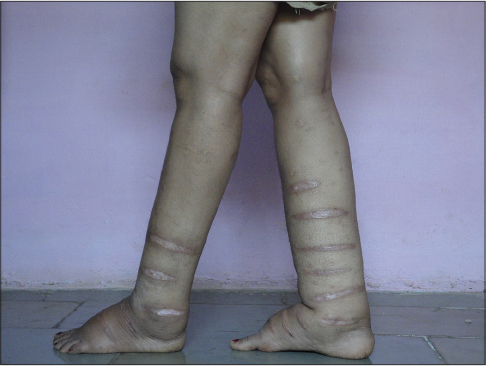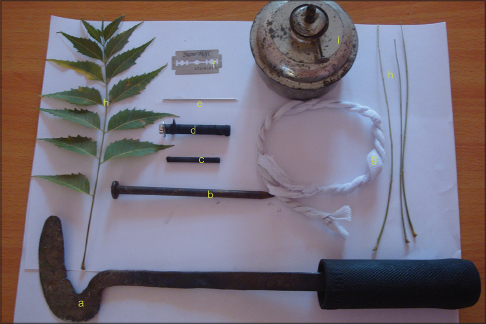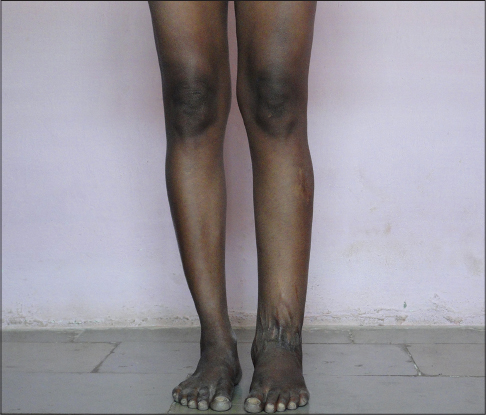Translate this page into:
Harmful traditional healing practices in the treatment of lymphatic filariasis
2 National Research Institute for Panchakarma (CCRAS), Thrissur, Kerala, India
3 Department of Dermatology, Churchill Hospital, Oxford, United Kingdom
Correspondence Address:
Saravu R Narahari
Institute of Applied Dermatology, Uliyathadka, Madhur Road, Kasaragod - 671 124, Kerala
India
| How to cite this article: Narahari SR, Manjula K, Bose KS, Aggithaya MG, Swamy GK, Ryan TJ. Harmful traditional healing practices in the treatment of lymphatic filariasis. Indian J Dermatol Venereol Leprol 2016;82:565-567 |
Sir,
Lymphatic filariasis is a mosquito-borne communicable lymphedema endemic in the Southern Indian district of Gulbarga. As part of providing integrative lymphatic filariasis treatment in endemic villages, we conducted 25 lymphatic filariasis village camps. Regular washing, treatment for bacterial entry points and body movements using yoga exercises were taught in 1-day camps.[1] Circular or linear scars were seen in 289 (38%) of 761 patients examined [Figure - 1]. These scars resulted from previous treatment on the legs by traditional health practitioners of the locality. This paper discusses the information obtained from these 289 patients.[1] Health care providers should be aware of traditional healing practices which are harmful and might be the cause of recurrent cellulitis in lymphedema.
 |
| Figure 1: Bilateral lymphedema showing multiple circular scar marks following cauterization using marking nut seed oil |
The patients in endemic villages are disabled by their swollen legs and suffer due to repeated fever episodes. Many were once breadwinners in their families. Most people live in clusters and huts which are difficult to live in areas. In addition, there is no access to biomedical treatment. It takes 7–9 h to reach tertiary hospitals to get inpatient care. These are the major reason for patients seeking treatment from the traditional health practitioners as advised by their peers. In each endemic village, there are 2–3 such traditional health practitioners who treat lymphedema. These health practitioners did not have any qualifications related to Indian systems of medicine or biomedicine. Some were “compounders” who worked in Ayurveda clinics or who were dispensing medicines in allopathy hospitals, some had a family practice of Ayurveda, while others practiced as traditional health practitioners in villages. It is also possible that these practitioners learned the procedures from Ayurveda experts and practiced this in their own style.
In Ayurveda, lymphedema is described as shleepada.[1] Venesection and cauterization at ankle level are the treatment options. S. anacardium Linn. seed oil, cow urine, calotropis, chaste tree leaves and garlic are recommended in Ayurveda to reduce edema, treat helminthiasis and to treat wounds.
We observed the healing practices in a clinic of traditional health practitioners. During the treatment procedure, the patient lies on the floor and accompanying persons hold the patient to prevent mobility as the treatment is painful. The procedure was done without anesthesia. The practitioners palpate to identify the vein and arbitrarily mark the locations to burn, cauterize with herbal seeds or cut. They burn the marked area with an iron nail heated red hot for an instant (or any one shown in [Figure - 2]). In venesection, the practitioner cuts open veins to let out “impure blood,” using a knife [Figure - 3] or blade [Figure - 4]. Patients are advised to apply curdon the wound to reduce burning pain. They were asked to avoid rice, brinjal (Solanum melongena), Bengal gram (Cicer arietinum) and potato (Solanum tuberosum L.) until the wound healed. In another patient, the ripened fruit of marking nut (Semecarpus anacardium L.) was heated on a pan, carefully opened and the oil applied on the marks [Figure - 1]. Later, the practitioner dusted alkaline wood ash, available in the kitchens of village communities, on the wound to avoid deep corrosion by the acidic oil. Following these procedures, the wound is kept open to heal. Traditional health practitioners do not wash their hands or disinfect the area of treatment before the procedure and were not aware of the need for any disinfection procedures.
 |
| Figure 2: The instruments used for cauterization: (a) Bent knife, (b) iron nail, (c and d) lead sticks of battery shell, (e) sewing needle, (f) razor blade, (g) cotton wick, (h) petiole of Azadirachta indica leaf, (i) kerosene lamp, used to heat the above materials |
 |
| Figure 3: Multiple, longitudinal scars on lymphedematous limb after venesection done by knife |
 |
| Figure 4: The lymphedematous limb showing longitudinal scars of venesection performed using a razor blade. This resulted in fibrosis in the ankle region |
Patients with chronic lymphedema gently massage the affected limb upwards using edible oil or kerosene (a combustible hydrocarbon liquid) after their daily work in the field. Traditional health practitioners also advise the application of a paste of cow's urine and ox dung for long-standing chronic cases. Patients are asked to immerse the swollen limb for 2 h in a pit, prepared by measuring the limb length, filled with sheep excreta and ash. Many patients are advised to wear a toe-ring made of alloy or copper on the great toe of the swollen limb. This ring was worn after offerings to god at nearby places of worship on new moon day.
Traditional care for inflammatory episodes (cellulitis) included application of paste of garlic (Allium sativum Linn.) pounded with red mud. Fifteen to 25 leaves of “five-leaved chaste tree,” (Vitex negundo Linn.) were fried on a pan, powdered and made into a paste in water. This was applied evenly on clean cotton cloth which was gently tied around the swollen limb overnight. Often 15–20 heated madar leaves (Calotropis procera R. Br.) [Figure - 5] were applied on the full length of the swollen limb and a clean cotton cloth was tied around the limb. Patients claimed that these procedures reduced pain and swelling.
 |
| Figure 5: A paste made of Calotropis procera R. Br. leaves was used as traditional home remedy to reduce pain and swelling during inflammatory episodes |
We educated traditional health practitioners on simple disinfection procedures such as washing their hands before undertaking a procedure and using spirit to disinfect the local area. As part of this study, we recorded traditional herbal knowledge that is in the public domain, identified herbals effective in skin care, photographed the source plants, recorded preparation of medicines and identified hazardous procedures, as recommended by the community dermatology task force.[2]
Financial support and sponsorship
Central Council for Research in Ayurvedic Sciences, Department of AYUSH, Ministry of Health and Family Welfare, Government of India.
Conflicts of interest
There are no conflicts of interest.
| 1. |
Narahari SR, Bose KS, Aggithaya MG, Swamy GK, Ryan TJ, Unnikrishnan B, et al. Community level morbidity control of lymphoedema using self care and integrative treatment in two lymphatic filariasis endemic districts of South India: A non randomized interventional study. Trans R Soc Trop Med Hyg 2013;107:566-77.
[Google Scholar]
|
| 2. |
Ryan TJ, Hirt HM, Willcox M. Collaboration with traditional health practitioners in the provision of skin care for all in Africa. Int J Dermatol 2011;50:564-70.
[Google Scholar]
|
Fulltext Views
6,689
PDF downloads
1,662





